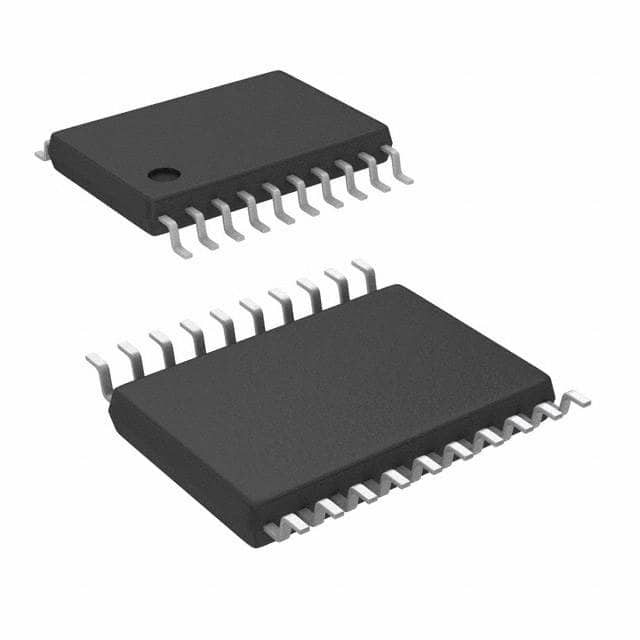Lihat spesifikasi untuk detail produk.

AD5254BRUZ50-RL7
Product Overview
Category
AD5254BRUZ50-RL7 belongs to the category of digital potentiometers.
Use
It is primarily used for electronic circuitry and systems that require variable resistance.
Characteristics
- Digital control interface
- Non-volatile memory
- Low power consumption
- Wide operating voltage range
- High resolution
Package
AD5254BRUZ50-RL7 comes in a small outline integrated circuit (SOIC) package.
Essence
The essence of AD5254BRUZ50-RL7 lies in its ability to provide precise and programmable resistance values in electronic circuits.
Packaging/Quantity
This product is typically packaged in reels, with 2500 units per reel.
Specifications
- Resistance Range: 0Ω to 50kΩ
- Number of Channels: 4
- Interface Type: I2C
- Operating Voltage Range: 2.7V to 5.5V
- Resolution: 256 steps
- Temperature Range: -40°C to +125°C
Detailed Pin Configuration
- VDD: Power supply voltage
- SDA: Serial data input/output
- SCL: Serial clock input
- GND: Ground
- A0: Address selection bit 0
- A1: Address selection bit 1
- WP: Write protect
- VSS: Negative power supply voltage
- R1A: Terminal A of resistor 1
- W1B: Wiper terminal of resistor 1
- R1B: Terminal B of resistor 1
- R2A: Terminal A of resistor 2
- W2B: Wiper terminal of resistor 2
- R2B: Terminal B of resistor 2
- R3A: Terminal A of resistor 3
- W3B: Wiper terminal of resistor 3
- R3B: Terminal B of resistor 3
- R4A: Terminal A of resistor 4
- W4B: Wiper terminal of resistor 4
- R4B: Terminal B of resistor 4
Functional Features
- Programmable resistance values
- Non-volatile memory for storing settings
- I2C interface for easy control and communication
- Low power consumption for energy efficiency
- Wide operating voltage range for versatility
- High resolution for precise adjustments
Advantages and Disadvantages
Advantages
- Precise and programmable resistance values
- Easy to control and communicate through the I2C interface
- Non-volatile memory ensures settings are retained even when power is lost
- Low power consumption helps conserve energy
- Wide operating voltage range allows for compatibility with various systems
- High resolution enables fine adjustments
Disadvantages
- Limited to 4 channels, may not be suitable for applications requiring more channels
- Relatively high cost compared to traditional potentiometers
Working Principles
AD5254BRUZ50-RL7 operates by digitally controlling the resistance value using a combination of switches and resistors. The digital control interface allows users to set the desired resistance value, which is then adjusted by varying the position of the wiper terminal along the resistor network. The non-volatile memory ensures that the resistance settings are retained even when power is disconnected.
Detailed Application Field Plans
AD5254BRUZ50-RL7 finds applications in various fields, including: 1. Audio equipment: Volume control, tone adjustment 2. Industrial automation: Process control, calibration 3. Test and measurement: Signal conditioning, calibration 4. Communication systems: Gain control, impedance matching
Detailed and Complete Alternative Models
- AD5252BRUZ50-RL7: Similar to AD5254BRUZ50-RL7 but with 2 channels instead of 4.
- AD5263BRUZ50-RL7: Higher resolution digital potentiometer with 1024 steps.
- MCP4018T-503E/OT: Low-cost alternative with similar specifications.
(Note: The above list is not exhaustive and there may be other alternative models available in the market.)
Word count: 527 words
Sebutkan 10 pertanyaan dan jawaban umum terkait penerapan AD5254BRUZ50-RL7 dalam solusi teknis
Sure! Here are 10 common questions and answers related to the application of AD5254BRUZ50-RL7 in technical solutions:
Q: What is the AD5254BRUZ50-RL7? A: The AD5254BRUZ50-RL7 is a digital potentiometer, specifically a quad-channel, I2C interface, nonvolatile memory (NVM) device.
Q: What is the purpose of using the AD5254BRUZ50-RL7? A: The AD5254BRUZ50-RL7 can be used to digitally control resistance in various applications, such as volume control, gain adjustment, and calibration.
Q: How many channels does the AD5254BRUZ50-RL7 have? A: The AD5254BRUZ50-RL7 has four independent channels, allowing for simultaneous control of multiple resistances.
Q: What is the communication interface used by the AD5254BRUZ50-RL7? A: The AD5254BRUZ50-RL7 uses the I2C (Inter-Integrated Circuit) interface for communication with a microcontroller or other devices.
Q: Can the AD5254BRUZ50-RL7 store its settings even when power is disconnected? A: Yes, the AD5254BRUZ50-RL7 has nonvolatile memory (NVM), which allows it to retain its settings even when power is removed.
Q: What is the resolution of the AD5254BRUZ50-RL7? A: The AD5254BRUZ50-RL7 has a resolution of 256 steps per channel, providing fine-grained control over resistance values.
Q: What is the maximum resistance range of the AD5254BRUZ50-RL7? A: The AD5254BRUZ50-RL7 has a maximum resistance range of 50 kΩ, which can be adjusted digitally.
Q: Can the AD5254BRUZ50-RL7 be used in both analog and digital circuits? A: Yes, the AD5254BRUZ50-RL7 can be used in both analog and digital circuits, providing flexibility in various applications.
Q: Is the AD5254BRUZ50-RL7 compatible with different supply voltages? A: Yes, the AD5254BRUZ50-RL7 operates within a wide supply voltage range of 2.7 V to 5.5 V, making it compatible with various systems.
Q: Are there any evaluation boards or development tools available for the AD5254BRUZ50-RL7? A: Yes, Analog Devices provides evaluation boards and software tools to aid in the development and testing of applications using the AD5254BRUZ50-RL7.
Please note that these answers are general and may vary depending on specific application requirements.

